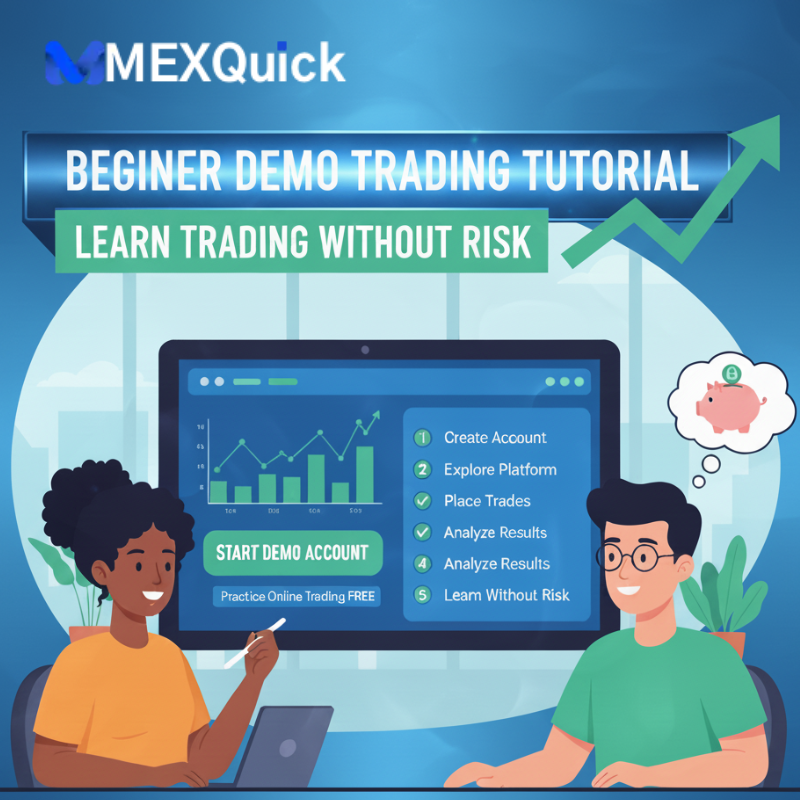
Let’s be real for a second. The thought of trading can be terrifying. You see charts with crazy lines, hear stories of people making fortunes, and then immediately hear worse stories of people losing their shirts. It’s enough to make anyone hesitate. What if I told you there’s a way to step into the world of trading with absolutely zero risk? A way to practice, make mistakes, and learn the ropes without your real money ever being on the line? That’s the magic of demo trading. Think of it as a flight simulator for traders. Before a pilot ever flies a $100 million plane with passengers, they spend hundreds of hours in a simulator, crashing over and over again without any real-world consequences. Demo trading is your financial flight simulator. In this beginner demo trading tutorial, I’ll guide you through exactly how to use demo trading for beginners effectively. We’ll cover everything from setting up your account to transitioning to real money, safely and confidently. My goal is to make this your ultimate step-by-step demo trading guide.
Why Every Beginner MUST Start with Demo Trading
Before we dive into the “how,” let’s solidify the “why.” Skipping demo trading is like trying to run before you can walk. Here’s why it’s non-negotiable:
-
Risk-Free Learning: This is the biggest benefit. You learn trading without risk. You can test strategies, see how the markets react to news, and get comfortable with the platform’s buttons without the gut-wrenching fear of loss.
-
Platform Familiarity: Trading platforms can be complex. A demo account lets you explore every feature—from placing orders to setting stop-losses—until it becomes second nature.
-
Strategy Validation: That “can’t lose” strategy you read about online? Test it in real-time market conditions with virtual money before you bet your hard-earned cash.
-
Builds Discipline and Confidence: Demo trading helps you develop the psychological muscles needed for real trading. You learn to manage emotions and stick to a plan in a safe environment.
Read More About :
- Forex brokers with free demo accounts
- Practice crypto trading free
- Learning strategy with demo account
Setting Up a Demo Trading Account: Your First Step

Getting started is surprisingly simple. The goal here is to start a demo trading account that mimics real trading as closely as possible.
-
Choose a Reputable Broker: Select a well-regulated broker that offers a demo account. Look for ones that are popular among beginners, as they often have better educational resources. (We’ll list some top platforms next).
-
Visit the Broker’s Website: Navigate to their website and look for a “Demo Account,” “Practice Account,” or “Open Free Account” option. It’s usually very prominent on the homepage.
-
Complete the Registration Form: You’ll typically need to provide your name, email address, and phone number. Since it’s a demo account, no financial information or deposits are required.
-
Download the Trading Platform: Most brokers will provide a link to download their platform (like MetaTrader 4 or 5) or will give you direct web-based access.
-
Log In and Explore: You’ll receive login credentials (a username and password) for your demo account. Log in, and you’ll see your account funded with virtual money—usually between $10,000 and $100,000.
Pro Tip: When setting up, choose a demo account balance that reflects the actual amount you plan to start trading with in the future. If you plan to start with $2,000, ask for a $2,000 demo account. This makes the experience more realistic.
A Step-by-Step Guide to Practice Trading Like a Pro
Okay, you’re logged in. The platform is open. Now what? Don’t just randomly click buttons. Follow this structured approach.
Step 1: Learn the Interface
Spend your first session just exploring. Identify these key areas:
-
The Chart Window: Where the price action happens.
-
The Market Watch: Lists the available assets (like EUR/USD, Gold, Apple stock).
-
The Terminal/Trade Window: Shows your open positions, order history, and current profit/loss.
-
Order Placement Panel: The window that pops up when you want to buy or sell.
Step 2: Execute Your First Trade
Let’s place a simple trade. We’ll use buying EUR/USD (the Euro against the US Dollar) as an example.
-
Find EUR/USD in the Market Watch list.
-
Right-click on it and select “New Order.”
-
A window will pop up. Here, you’ll see:
-
Volume/Lot Size: This is the trade amount. Start small (e.g., 0.10 lots).
-
Stop Loss: A pre-set price to automatically close the trade if it goes against you, limiting your loss. Always use this!
-
Take Profit: A pre-set price to automatically close the trade when it reaches a certain profit.
-
-
Click “Buy” or “Sell” to execute the trade.
Step 3: Manage Your Open Trade
Once the trade is open, watch how it behaves. See how your profit/loss fluctuates. Practice moving your stop loss to “break even” if the trade goes in your favor. This is a key risk management skill.
Best Platforms for Beginner Demo Trading
Not all platforms are created equal. Here are two of the best for beginners:
| Platform | Best For | Key Features |
|---|---|---|
| MetaTrader 4 (MT4) | Forex & CFD Traders | The industry standard. Simple interface, huge community, thousands of free indicators and automated trading robots (Expert Advisors). |
| MetaTrader 5 (MT5) | Stock & Multi-Asset Traders | MT4’s more advanced sibling. Allows trading of stocks and futures directly, along with more technical indicators and timeframes. |
| Broker-Specific Web Platform | Absolute Beginners | Brokers like Plus500, eToro, and IG have their own intuitive web and mobile platforms. Great for getting started quickly. |
Quick Tips to Master Demo Trading: Treat It Like Real Money
This is the most important section. Most people fail at demo trading because they treat it like a game. Don’t make that mistake. To truly master demo trading, follow these rules:
-
Start with a Trading Plan: Define your goals. What do you want to learn? What strategy will you test? How much virtual money are you willing to risk per trade (e.g., no more than 1-2%)?
-
Embrace Realism: That $50,000 in virtual money is not a lottery ticket. Trade with the same size and risk tolerance you would with your real $1,000 or $2,000.
-
Keep a Trading Journal: This is a game-changer. Record every trade: why you entered, why you exited, the outcome, and, crucially, how you felt. Review it weekly to spot mistakes.
-
Practice One Strategy at a Time: Don’t jump from scalping to swing trading. Master one approach before moving to the next.
-
Don’t Chase Losses: If you have a losing streak, the temptation is to place a huge trade to win it all back. This is a disastrous habit. Stick to your plan.
Transitioning from Demo to Live Trading Safely
So, you’ve been consistently profitable on demo for a few months. You feel confident. It’s time to go live, right? Slow down. The transition is a psychological minefield.
-
Start SMALL: Fund your live account with a small amount of money you are 100% comfortable losing. This takes the pressure off.
-
Trade Micro Lots: Even with a real account, start with the smallest possible trade size (e.g., 0.01 lots). The goal isn’t to get rich; it’s to get used to the psychology of real money on the line.
-
Expect a Difference: It will feel different. You might feel fear or greed for the first time. Acknowledge it, and fall back on the discipline you built in your demo account.
-
Consider a Cent Account: Some brokers offer “cent accounts,” where 1 lot is worth 1 cent instead of $10. This is a fantastic bridge between demo and standard live trading.
Key Takeaways and Your Action Plan
You now have a complete blueprint for how to use demo trading for beginners. Let’s recap the actionable steps:
-
Get Started Today: Choose a broker from the list above and open your demo account.
-
Be Patient and Structured: Don’t rush. Use your demo time to learn the platform, test strategies, and build discipline.
-
Treat Virtual Money Seriously: The habits you form now will follow you to live trading.
-
Journal Everything: Your trading journal is your best teacher.
-
Transition Gradually: When moving to real money, start small to manage the psychological shift.
Demo trading is the most powerful, risk-free tool a new trader has. Used correctly, it can be the difference between becoming a confident, disciplined trader and becoming another statistic.
The financial markets aren’t going anywhere. There’s no rush. Take your time, practice online trading for free, and build a solid foundation. Your future self will thank you for it.
Now, I’d love to hear from you. What’s the biggest question you have about starting with demo trading? Let me know in the comments below
